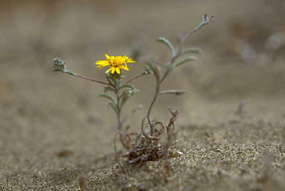San Francisco lessingia facts for kids
Quick facts for kids San Francisco lessingia |
|
|---|---|
 |
|
| Conservation status | |
| Scientific classification | |
| Kingdom: | |
| (unranked): | |
| (unranked): | |
| (unranked): | |
| Order: | |
| Family: | |
| Tribe: |
Astereae
|
| Genus: | |
| Species: |
L. germanorum
|
| Binomial name | |
| Lessingia germanorum |
|
The San Francisco lessingia (Lessingia germanorum) is a very rare flowering plant. It's part of the daisy family. You can only find it naturally in California, mostly around San Francisco. This plant is so rare that it's listed as an endangered species by both the state and federal governments. Many things threaten it, like plants from other places, building new things, and even people driving off-road vehicles where it grows. Pollution and losing its home also make it harder for this special plant to survive.
What Does the San Francisco Lessingia Look Like?
This plant is an annual herb, meaning it lives for only one year. It has a reddish stem that can grow up to 30 centimeters (about 12 inches) long. Its leaves are deeply cut, almost like fingers, and are about 3 to 4 centimeters long.
Some of the leaves and new parts of the stem have a soft, woolly coating. The plant's flowers grow in a single flower head or a small group of heads at the very top of the stem. These flower heads are bell-shaped.
The flower head has no large, petal-like ray florets, like a typical daisy. Instead, it has several small, golden, tube-shaped flowers. These tiny flowers have lobes that spread out, making them look a bit like rays. The San Francisco lessingia blooms from July all the way through November. After flowering, it produces a small, dry fruit called an achene, which has a whitish, feathery top.
Where Does the San Francisco Lessingia Live?
This special plant grows in sandy places, like sand dunes and sandy scrub areas. It naturally lives at the very tip of the San Francisco Peninsula. This area is now very developed with lots of buildings and cities.
One group of these plants was found in 1989 on San Bruno Mountain, near Daly City. This group is in danger because new houses are being built very close to where the plants grow.
The biggest group of San Francisco lessingia plants lives in the dunes near the mouth of Lobos Creek in the Presidio of San Francisco. However, this area faces big problems from plants that aren't native to California.
Threats to the San Francisco Lessingia
One major threat is a plant called ice plant (Carpobrotus sp.). This plant spreads out and covers the sand dunes like a thick mat. The ice plant makes the sand stay still, but the lessingia needs the sand to shift and move with the wind to grow well.
Other non-native trees also cause problems. Old Monterey cypress (Cupressus macrocarpa) and Monterey pine (Pinus radiata) trees were planted in the Presidio dunes many years ago. Even though these trees are native to California, they don't naturally grow in this specific ecosystem. They have changed the habitat, making it harder for the San Francisco lessingia to survive.


